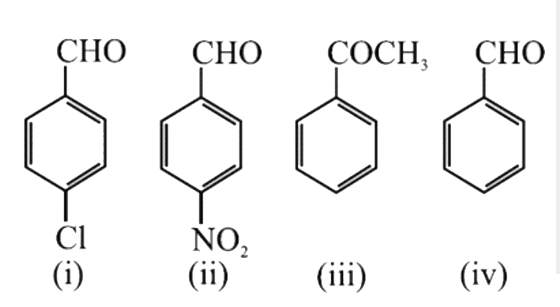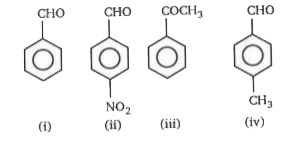Reaction of carbonyl compound with one of the following reagents involves nucleophilic addition followed by elimination of water. The reagent is:
Hydrocyanic acid
Sodium hydrogen sulphite
A Grignard reagent
Hydrazine in presence of feebly acidic solution
The correct Answer is:D
To solve the question regarding the reaction of a carbonyl compound with a reagent that involves nucleophilic addition followed by the elimination of water, we can follow these steps:
Step 1: Identify the Carbonyl Compound
A carbonyl compound has a functional group characterized by a carbon atom double-bonded to an oxygen atom (C=O). This includes aldehydes and ketones.
Step 2: Understand Nucleophilic Addition
Nucleophilic addition involves a nucleophile attacking the electrophilic carbon atom of the carbonyl group. In our case, we are considering the reaction with hydrazine (NH2-NH2), which acts as a nucleophile.
Step 3: Reaction with Hydrazine
When hydrazine reacts with a carbonyl compound, the nitrogen in hydrazine attacks the carbonyl carbon, leading to the formation of a tetrahedral intermediate. This intermediate can be represented as follows:
1. The carbonyl compound (R1C=O) reacts with hydrazine (NH2-NH2).
2. The nucleophile (NH2) attacks the carbonyl carbon, resulting in the formation of an intermediate with an -OH group and an -NH2 group attached to the same carbon.
Step 4: Formation of the Intermediate
The intermediate can be represented as:
- R1C(OH)(NH2)-NH2
Step 5: Elimination of Water
The next step is the elimination of water (H2O) from the intermediate. This occurs when one of the hydrogen atoms from the -NH2 group and the hydroxyl group (-OH) are removed, resulting in the formation of a double bond between carbon and nitrogen:
- The elimination can be represented as:
- R1C(NH2)=N-H + H2O
Step 6: Final Product
The final product formed after the elimination of water is called a hydrazone. The structure can be represented as:
- R1C=N-NH2
Conclusion
Thus, the reagent that facilitates nucleophilic addition followed by the elimination of water is hydrazine (NH2-NH2).
A carbonyl compound has a functional group characterized by a carbon atom double-bonded to an oxygen atom (C=O). This includes aldehydes and ketones.
Nucleophilic addition involves a nucleophile attacking the electrophilic carbon atom of the carbonyl group. In our case, we are considering the reaction with hydrazine (NH2-NH2), which acts as a nucleophile.
When hydrazine reacts with a carbonyl compound, the nitrogen in hydrazine attacks the carbonyl carbon, leading to the formation of a tetrahedral intermediate. This intermediate can be represented as follows:
2. The nucleophile (NH2) attacks the carbonyl carbon, resulting in the formation of an intermediate with an -OH group and an -NH2 group attached to the same carbon.
The intermediate can be represented as:
- R1C(OH)(NH2)-NH2
The next step is the elimination of water (H2O) from the intermediate. This occurs when one of the hydrogen atoms from the -NH2 group and the hydroxyl group (-OH) are removed, resulting in the formation of a double bond between carbon and nitrogen:
- R1C(NH2)=N-H + H2O
The final product formed after the elimination of water is called a hydrazone. The structure can be represented as:
- R1C=N-NH2
Thus, the reagent that facilitates nucleophilic addition followed by the elimination of water is hydrazine (NH2-NH2).
Similar Questions
Knowledge Check
Which of the following compounds is most reactive towards nucleophilic addition reactions ?
ACH3−O∣∣C−HBCH3−O∣∣C−CH3C D
D
Which of the following compounds is most reactive towards nucleophilic addition reactions ?
ACH3−O∣∣C−HBCH3−O∣∣C−CH3C D
D
Which of the following compounds is most reactive towards nucleophilic addition reactions ?
ACH3−O∣∣C−HBCH3−O∣∣C−CH3C D
D
Which one of the following reagents is not suitable for the elimination reaction?

View SolutionArrange the following carbonyl compounds in decreasing order of their reactivity in nucleophilic addition reaction :

View SolutionSelect the reagent for the following reaction

View SolutionWhich of the following compounds is most reactive towards nucleophilic addition reactions ?
View SolutionArrange the following carbonyl compounds in decreasing order of their reactivity in nucleophilic addition reaction.

View Solution
